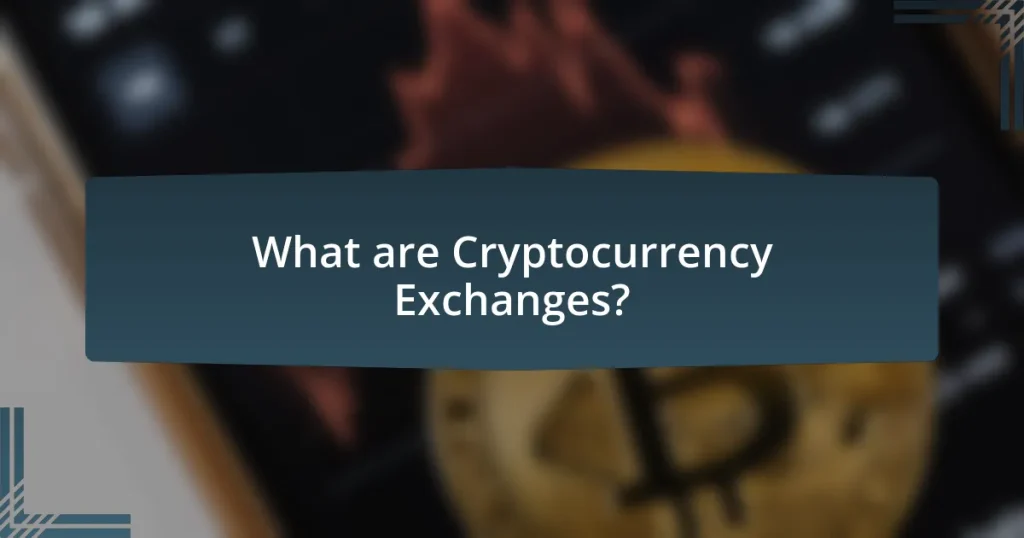Cryptocurrency exchanges are platforms that enable the buying, selling, and trading of digital assets, playing a crucial role in the cryptocurrency ecosystem. This article explores the evolution of these exchanges, distinguishing between centralized exchanges (CEXs) and decentralized exchanges (DEXs), highlighting their operational mechanisms, advantages, and disadvantages. Key components such as liquidity, security measures, and regulatory compliance are examined, along with the historical context of early exchanges and significant milestones that have shaped the market. Additionally, emerging trends, user preferences, and factors influencing the choice between CEXs and DEXs are discussed, providing a comprehensive overview of the current landscape of cryptocurrency trading.

What are Cryptocurrency Exchanges?
Cryptocurrency exchanges are platforms that facilitate the buying, selling, and trading of cryptocurrencies. These exchanges operate by matching buyers with sellers, allowing users to exchange digital assets for other cryptocurrencies or fiat currencies. According to a report by CoinMarketCap, as of 2023, there are over 400 cryptocurrency exchanges globally, highlighting their significance in the digital asset ecosystem.
How do Cryptocurrency Exchanges function?
Cryptocurrency exchanges function as platforms that facilitate the buying, selling, and trading of cryptocurrencies. They operate by matching buyers and sellers through order books, where users can place orders to purchase or sell digital assets at specified prices. Centralized exchanges, such as Binance and Coinbase, manage these transactions and hold users’ funds, providing liquidity and security, while decentralized exchanges, like Uniswap, allow peer-to-peer trading without a central authority, relying on smart contracts to execute trades. The efficiency of these exchanges is supported by their ability to process numerous transactions per second, with centralized exchanges often handling billions of dollars in daily trading volume, demonstrating their critical role in the cryptocurrency ecosystem.
What are the key components of a Cryptocurrency Exchange?
The key components of a cryptocurrency exchange include a trading platform, liquidity, security measures, user interface, and regulatory compliance. The trading platform serves as the core software that facilitates transactions between buyers and sellers. Liquidity is essential for ensuring that trades can be executed quickly and at stable prices, often provided by market makers or through user participation. Security measures, such as two-factor authentication and cold storage for assets, protect users’ funds and personal information. A user-friendly interface enhances the trading experience, making it accessible to both novice and experienced traders. Finally, regulatory compliance ensures that the exchange adheres to legal standards, which can vary by jurisdiction, thereby fostering trust among users.
How do these components interact within the exchange?
The components within a cryptocurrency exchange interact through a structured framework that facilitates trading, security, and user experience. In centralized exchanges, the platform acts as an intermediary, managing order books, executing trades, and holding user funds, which allows for faster transactions but introduces risks related to trust and security. In decentralized exchanges, smart contracts enable peer-to-peer trading without a central authority, enhancing privacy and control for users while potentially increasing transaction times and complexity. The interaction between these components is crucial for determining the efficiency, security, and user satisfaction of the exchange, as evidenced by the varying user adoption rates and transaction volumes observed in both types of exchanges.
What types of Cryptocurrency Exchanges exist?
There are primarily two types of cryptocurrency exchanges: centralized exchanges (CEX) and decentralized exchanges (DEX). Centralized exchanges are platforms operated by companies that facilitate trading between users, providing services such as order matching and custody of funds. Examples include Binance and Coinbase, which dominate the market due to their user-friendly interfaces and high liquidity. In contrast, decentralized exchanges operate without a central authority, allowing users to trade directly with one another through smart contracts. Uniswap and SushiSwap are notable examples, emphasizing user control and privacy. The existence of these two types reflects the diverse needs of cryptocurrency users, with centralized exchanges offering convenience and DEXs providing autonomy.
What distinguishes Centralized Exchanges from Decentralized Exchanges?
Centralized Exchanges (CEXs) are distinguished from Decentralized Exchanges (DEXs) primarily by their operational structure and control mechanisms. CEXs are managed by a central authority that facilitates trading, holds user funds, and provides liquidity, which allows for faster transactions and user-friendly interfaces. In contrast, DEXs operate on a peer-to-peer basis without a central authority, enabling users to trade directly from their wallets, which enhances privacy and security but may result in slower transaction speeds and a steeper learning curve for users. The reliance on a central entity in CEXs can lead to vulnerabilities such as hacks or regulatory scrutiny, while DEXs mitigate these risks by decentralizing control, although they may face challenges like lower liquidity and limited customer support.
What are the advantages and disadvantages of each type?
Centralized cryptocurrency exchanges offer advantages such as higher liquidity, faster transaction speeds, and user-friendly interfaces, making them accessible for beginners. However, they also present disadvantages, including a single point of failure, vulnerability to hacks, and regulatory scrutiny, which can compromise user privacy and control over funds.
In contrast, decentralized exchanges provide advantages like enhanced security, user control over funds, and reduced regulatory risks, as they operate without a central authority. Nonetheless, they face disadvantages such as lower liquidity, slower transaction speeds, and a steeper learning curve for users unfamiliar with blockchain technology.

How have Cryptocurrency Exchanges evolved over time?
Cryptocurrency exchanges have evolved significantly from their inception in 2010, transitioning from simple platforms for trading Bitcoin to complex ecosystems that facilitate a wide range of digital assets. Initially, exchanges like Mt. Gox primarily supported Bitcoin trading, but as the market matured, platforms began to offer altcoins, advanced trading features, and enhanced security measures.
The introduction of centralized exchanges, such as Binance and Coinbase, provided users with user-friendly interfaces, liquidity, and regulatory compliance, which attracted a broader audience. In contrast, decentralized exchanges (DEXs) emerged around 2014, allowing peer-to-peer trading without intermediaries, thus enhancing privacy and reducing the risk of hacks associated with centralized platforms.
By 2021, the rise of decentralized finance (DeFi) further accelerated the evolution of exchanges, with DEXs like Uniswap and SushiSwap enabling automated trading through smart contracts. This shift reflects a growing demand for user control over assets and a desire for transparency in transactions. Overall, the evolution of cryptocurrency exchanges illustrates a dynamic landscape that balances user experience, security, and regulatory considerations.
What were the early forms of Cryptocurrency Exchanges?
The early forms of cryptocurrency exchanges were primarily peer-to-peer platforms and centralized exchanges. Peer-to-peer exchanges, such as LocalBitcoins, allowed users to trade directly with one another, facilitating transactions without an intermediary. Centralized exchanges, like Mt. Gox, emerged shortly after, providing a platform for users to trade cryptocurrencies in a more structured environment, often with order books and liquidity. Mt. Gox, launched in 2010, became one of the first significant centralized exchanges, handling a large volume of Bitcoin transactions before its collapse in 2014. These early exchanges laid the groundwork for the evolution of both centralized and decentralized trading platforms in the cryptocurrency market.
How did the first exchanges operate?
The first exchanges operated primarily as platforms for trading cryptocurrencies directly between users, often using a simple order book system. These early exchanges, such as BitcoinMarket.com launched in 2010, facilitated trades by matching buy and sell orders, allowing users to exchange Bitcoin for fiat currencies or other cryptocurrencies. The operation relied on users creating accounts, depositing funds, and placing orders, which were then executed based on market demand and supply. This model established the foundational mechanics of trading that would evolve into more complex systems in later exchanges.
What challenges did early exchanges face?
Early exchanges faced significant challenges, including security vulnerabilities, regulatory uncertainty, and liquidity issues. Security vulnerabilities were prevalent as many exchanges experienced hacks, leading to substantial losses; for instance, Mt. Gox, once the largest exchange, lost approximately 850,000 Bitcoins in 2014 due to a security breach. Regulatory uncertainty arose as governments struggled to define and regulate cryptocurrencies, creating an unpredictable environment for exchanges. Additionally, liquidity issues hindered trading, as early exchanges often lacked sufficient volume, making it difficult for users to execute trades without significant price slippage. These challenges collectively impacted the growth and stability of early cryptocurrency exchanges.
What major milestones have shaped the evolution of Cryptocurrency Exchanges?
The evolution of cryptocurrency exchanges has been shaped by several major milestones, including the launch of Bitcoin in 2009, the establishment of the first exchange, Mt. Gox, in 2010, and the introduction of decentralized exchanges (DEXs) in the mid-2010s. Bitcoin’s introduction marked the beginning of cryptocurrency trading, while Mt. Gox facilitated the first significant trading volume, handling over 70% of all Bitcoin transactions at its peak. The emergence of DEXs, such as EtherDelta in 2017, allowed users to trade directly without intermediaries, enhancing security and privacy. These milestones collectively transformed the landscape of cryptocurrency trading, influencing regulatory approaches and user adoption.
How did regulatory changes impact the development of exchanges?
Regulatory changes significantly influenced the development of exchanges by establishing frameworks that govern their operations and enhance user trust. For instance, the implementation of the Financial Action Task Force (FATF) guidelines in 2019 required exchanges to adopt Know Your Customer (KYC) and Anti-Money Laundering (AML) practices, leading to increased compliance costs but also fostering a more secure trading environment. Additionally, regulations in various jurisdictions, such as the European Union’s Markets in Crypto-Assets (MiCA) proposal, have aimed to create a harmonized regulatory landscape, encouraging institutional participation and innovation in the exchange sector. These regulatory measures have shaped the operational models of both centralized and decentralized exchanges, driving them to adapt to legal requirements while striving to maintain user accessibility and security.
What technological advancements have influenced exchange operations?
Technological advancements such as blockchain technology, automated trading systems, and artificial intelligence have significantly influenced exchange operations. Blockchain technology enables secure, transparent transactions and eliminates the need for intermediaries, which is crucial for both centralized and decentralized exchanges. Automated trading systems facilitate high-frequency trading, allowing exchanges to process large volumes of transactions quickly and efficiently. Additionally, artificial intelligence enhances trading strategies through predictive analytics and risk management, improving overall market efficiency. These advancements collectively contribute to the evolution and functionality of cryptocurrency exchanges.

What are the key differences between Centralized and Decentralized Exchanges?
Centralized exchanges (CEXs) are platforms where transactions are facilitated by a central authority, while decentralized exchanges (DEXs) operate without a central authority, allowing peer-to-peer trading. CEXs typically offer higher liquidity and faster transaction speeds due to their centralized nature, which can lead to better user experience and customer support. In contrast, DEXs provide greater privacy and security since users retain control of their funds and personal information, reducing the risk of hacks associated with centralized platforms. Additionally, CEXs often require users to complete identity verification processes, whereas DEXs usually allow anonymous trading. These fundamental differences highlight the trade-offs between convenience and control in the cryptocurrency trading landscape.
How do Centralized Exchanges operate?
Centralized exchanges operate by acting as intermediaries between buyers and sellers of cryptocurrencies. These platforms facilitate trading by matching orders from users, maintaining an order book, and providing a user-friendly interface for transactions. Centralized exchanges typically require users to create accounts and deposit funds, which the exchange holds in its custody, allowing for easier trading and liquidity.
For example, platforms like Binance and Coinbase manage user funds and execute trades on behalf of their clients, ensuring that transactions are processed quickly and efficiently. This model allows for higher trading volumes and faster execution times compared to decentralized exchanges, which often rely on peer-to-peer transactions. Centralized exchanges also implement security measures, such as two-factor authentication and cold storage, to protect user assets.
What security measures are typically employed by Centralized Exchanges?
Centralized exchanges typically employ a range of security measures including cold storage, two-factor authentication (2FA), and regular security audits. Cold storage involves keeping the majority of user funds offline to protect them from hacking attempts, while 2FA adds an extra layer of security by requiring users to verify their identity through a secondary device. Regular security audits help identify vulnerabilities in the system, ensuring that any potential weaknesses are addressed promptly. These measures are critical in safeguarding user assets and maintaining trust in the exchange platform.
What are the risks associated with using Centralized Exchanges?
The risks associated with using Centralized Exchanges include security vulnerabilities, regulatory issues, and lack of control over funds. Centralized Exchanges are often targets for hacking, as evidenced by incidents like the Mt. Gox hack in 2014, where approximately 850,000 Bitcoins were stolen, highlighting the potential for significant financial loss. Additionally, these exchanges may face regulatory scrutiny, which can lead to sudden shutdowns or restrictions, as seen in various countries imposing regulations on cryptocurrency trading. Lastly, users do not have full control over their funds, as they must deposit assets into the exchange’s wallet, increasing the risk of loss if the exchange faces insolvency or operational issues.
How do Decentralized Exchanges function?
Decentralized exchanges function by enabling peer-to-peer trading of cryptocurrencies without the need for a central authority. They utilize smart contracts on blockchain technology to facilitate transactions directly between users, ensuring that trades are executed automatically when predefined conditions are met. This model enhances security and privacy, as users retain control of their funds and personal information throughout the trading process. According to a report by CoinGecko, decentralized exchanges accounted for approximately 20% of the total trading volume in the cryptocurrency market as of 2021, highlighting their growing significance in the ecosystem.
What are the benefits of using Decentralized Exchanges?
Decentralized exchanges (DEXs) offer several benefits, including enhanced security, privacy, and control over funds. Users retain ownership of their assets, reducing the risk of hacks associated with centralized exchanges, where funds are stored in a single location. Additionally, DEXs facilitate peer-to-peer trading without the need for intermediaries, which can lower transaction fees and increase accessibility. According to a report by CoinGecko, DEX trading volume reached over $200 billion in 2021, highlighting their growing popularity and trust among users.
What limitations do Decentralized Exchanges face?
Decentralized exchanges face several limitations, including lower liquidity compared to centralized exchanges, which can lead to higher price volatility and slippage during trades. Additionally, they often lack user-friendly interfaces, making them less accessible for novice traders. Security vulnerabilities, such as smart contract bugs, can also pose risks, as users are responsible for their own funds without the safety net of a centralized authority. Furthermore, regulatory challenges arise due to the pseudonymous nature of transactions, complicating compliance with anti-money laundering (AML) and know-your-customer (KYC) regulations. These factors collectively hinder the widespread adoption and functionality of decentralized exchanges in the cryptocurrency market.
What trends are emerging in the Cryptocurrency Exchange landscape?
Emerging trends in the cryptocurrency exchange landscape include the rise of decentralized exchanges (DEXs), increased regulatory scrutiny, and the integration of advanced technologies like artificial intelligence and blockchain analytics. DEXs are gaining popularity due to their ability to offer users greater control over their assets and enhanced privacy, with platforms like Uniswap and SushiSwap leading the way. Regulatory bodies are increasingly focusing on cryptocurrency exchanges to ensure compliance with anti-money laundering (AML) and know your customer (KYC) regulations, as seen in the actions taken by the Financial Action Task Force (FATF). Additionally, the use of AI and blockchain analytics is becoming more prevalent, enabling exchanges to improve security measures and enhance user experience through personalized services. These trends reflect a significant shift towards more secure, user-centric, and compliant trading environments in the cryptocurrency exchange sector.
How are user preferences shifting between Centralized and Decentralized Exchanges?
User preferences are increasingly shifting towards Decentralized Exchanges (DEXs) due to their enhanced security, privacy, and control over funds. Centralized Exchanges (CEXs) have historically dominated the market, but incidents of hacks and regulatory scrutiny have led users to seek alternatives that offer greater autonomy. According to a report by Chainalysis, the volume of trades on DEXs surged by over 1,000% in 2021, indicating a significant trend towards decentralized platforms. This shift is further supported by the growing awareness of the benefits of blockchain technology, which allows users to trade directly without intermediaries, thus reducing the risk of asset loss and enhancing transaction transparency.
What innovations are being introduced in the exchange market?
Innovations in the exchange market include the introduction of decentralized finance (DeFi) platforms, which enable peer-to-peer trading without intermediaries, enhancing security and reducing fees. Additionally, automated market makers (AMMs) are being utilized to facilitate liquidity provision, allowing users to trade directly against liquidity pools rather than relying on traditional order books. Furthermore, the integration of blockchain technology is improving transparency and traceability in transactions, while non-fungible tokens (NFTs) are expanding the types of assets that can be traded on exchanges. These advancements are reshaping the landscape of cryptocurrency exchanges, making them more efficient and accessible.
What should users consider when choosing between Centralized and Decentralized Exchanges?
Users should consider security, control, liquidity, and user experience when choosing between Centralized and Decentralized Exchanges. Centralized Exchanges typically offer higher liquidity and faster transactions, making them user-friendly for trading. However, they require users to trust the platform with their funds, which can be vulnerable to hacks, as evidenced by the 2014 Mt. Gox incident where $450 million was stolen. In contrast, Decentralized Exchanges provide users with greater control over their assets and enhanced privacy, as they do not require personal information. However, they may have lower liquidity and can be more complex to navigate, which can deter less experienced users. Therefore, the choice hinges on the user’s priorities regarding security, ease of use, and control over their assets.
What factors influence the decision-making process for users?
The decision-making process for users is influenced by factors such as trust, security, user experience, and available features. Trust is critical, as users prefer exchanges with a strong reputation and positive reviews, which can be supported by data showing that 80% of users rely on peer recommendations. Security is paramount, with users gravitating towards platforms that implement robust security measures, evidenced by the fact that exchanges with two-factor authentication see a 30% higher user retention rate. User experience, including interface design and ease of navigation, significantly impacts decisions, as studies indicate that 70% of users abandon platforms that are difficult to use. Lastly, the range of features offered, such as trading options and customer support, also plays a vital role, with research showing that users are 60% more likely to choose exchanges that provide comprehensive trading tools and responsive customer service.
How can users ensure their security and privacy on exchanges?
Users can ensure their security and privacy on exchanges by implementing strong security practices such as enabling two-factor authentication (2FA), using hardware wallets for storage, and regularly updating passwords. Two-factor authentication adds an extra layer of security by requiring a second form of verification, significantly reducing the risk of unauthorized access. Hardware wallets, which store private keys offline, protect users from online threats, as they are less susceptible to hacking. Regularly updating passwords helps mitigate risks associated with data breaches, as outdated passwords can be easily compromised. According to a report by the Cybersecurity & Infrastructure Security Agency, using 2FA can prevent 99.9% of automated attacks, highlighting its effectiveness in enhancing security on exchanges.










